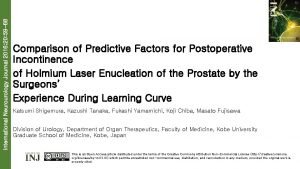International Neurourology Journal 2016 20 13 17 Update



- Slides: 3

International Neurourology Journal 2016; 20: 13 -17 Update on the Pathology and Diagnosis of Interstitial Cystitis Bladder Pain Syndrome: A Review Hyun-Jung Kim Department of Pathology, Inje University Sanggye Paik Hospital, Seoul, Korea This is an Open Access article distributed under the terms of the Creative Commons Attribution Non-Commercial License (http: //creativecommons. org/licenses/by-nc/3. 0/) which permits unrestricted non-commercial use, distribution, and reproduction in any medium, provided the original work is properly cited.

International Neurourology Journal 2016; 20: 13 -17 • Interstitial cystitis/bladder pain syndrome (IC/BPS) is characterized by bladder discomfort, urinary frequency, urgency, and pelvic pain. • The etiology and pathogenesis of this condition is still unknown and remains diagnosed by exclusion. • The histologic findings are also neither specific for diagnosis nor correlated with symptoms. • However, the definition and diagnostic criteria for the condition was established in the last decade. • In this paper, we review the changes in the definition, terminology, and diagnostic scheme of IC/BPS, and summarize the histologic findings. • We also briefly discuss some new pathologic suggestions and new urinary markers, focusing on the most promising ones.

International Neurourology Journal 2016; 20: 13 -17 • At this time, IC/BPS remains a diagnosis of exclusion. • Independent of ESSIC recommendations, the first line of diagnosis is patient selection based on symptoms and an exclusion of other diseases with similar presentation. • In addition, cystoscopy and biopsy can help with confirmation and classification. • Finally, updated pathophysiologic knowledge including numerous urinary biomarkers has led to changes in the diagnostic criteria.




